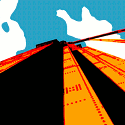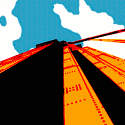Looking Backward (notes)
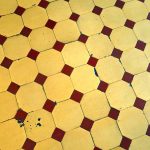
Collected discussion and working notes for Looking Backward, performed as part of our part of our Long Beach SoundWalk 2012 project.
Contents
- Notes
- 1.1 Planning Session: 2012 August 08
- 1.2 Planning Session: 2012 August 26
- 1.3 Useful Links
- 1.4 Meta: Migrate Scaffolding to This Page
- 1.5 Meta: Talk page etiquette
- 1.6 Layers vs. Sections
- 1.7 Mark Hammons re: Loss Evinced by Bradbury Building
- 1.8 LA Conservancy vs. Actual Architect’s Identity
- 1.9 One Man’s Discovery
- 1.10 Echoes
- 1.11 Journal
- 1.12 The Reality
Notes
Planning Session: 2012 August 08
- Bellamy’s Utopia v. today’s dystopia
- Jacob keep reading and highlighting
- “I dreamed I sat on the throne” passage is fascinating and evocative, but…WTF?
- Contrast vision of Boston with Romneyan campaign proclamations
- Both from Massachusetts! (handy)
- Bek to research
- Can we get it across without being strident?
- Dave to search archives for industrial sounds
- Futuristic sounds?
- Does this one even /have/ violin? (not so far)
- Next session: Friday 2012-08-10
- Run through Oracle_du_Jour
- Warm up with Buzz
Planning Session: 2012 August 26
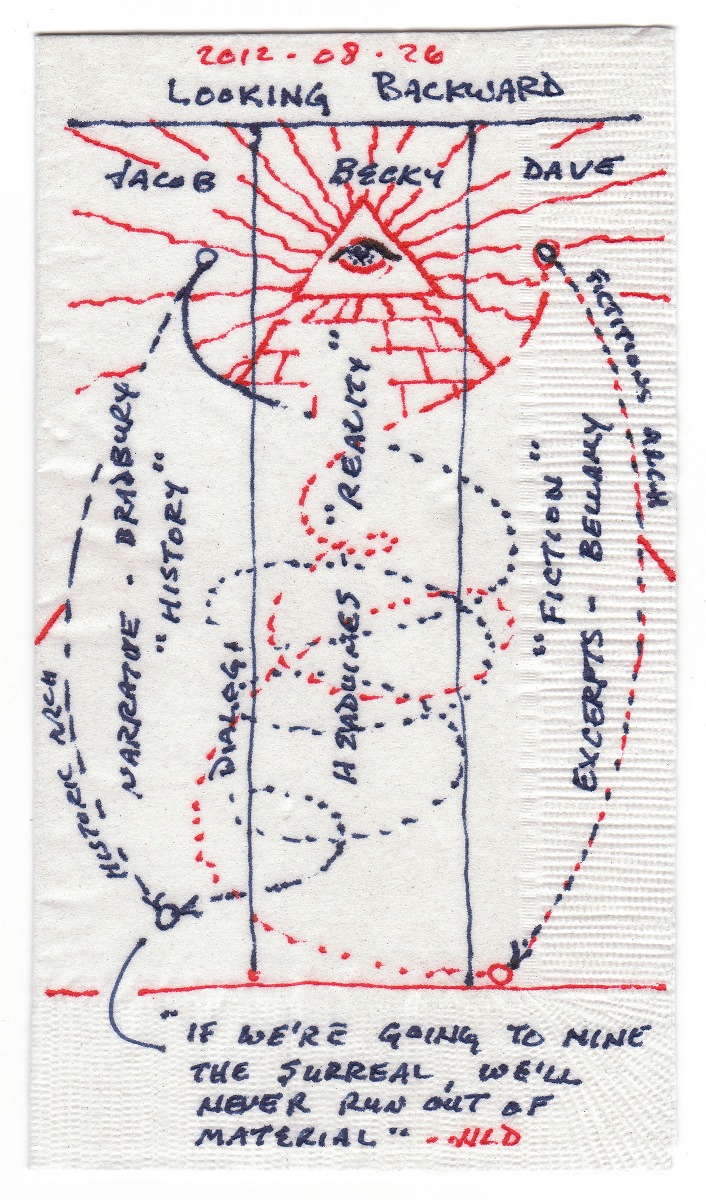
Dave’s impromptu schema for Looking Backward
Creative collaboration is a fascinating process, something akin perhaps to brewing beer in Belgium. Spores gather at random in the open air. The brewer’s faith is placed in serendipity, itself leavened with knowledge of past success. The largely unguided and private fermentation processes complete on their own before we circle back to the stated goal of bottling a product. It’s all very abstract. Until it isn’t.
Sometimes it even happens in time for the performance.
So that was this morning’s question: What form should Looking Backward take? Are the three parts sequential, or conceptual? Now that the material is starting to pile up, how to organize it for performance? See below…asked and answered August 08, but apparently not very clearly. As often happens, Jacob and Rebecca took the bull by the horns in conference while Dave took “notes.”
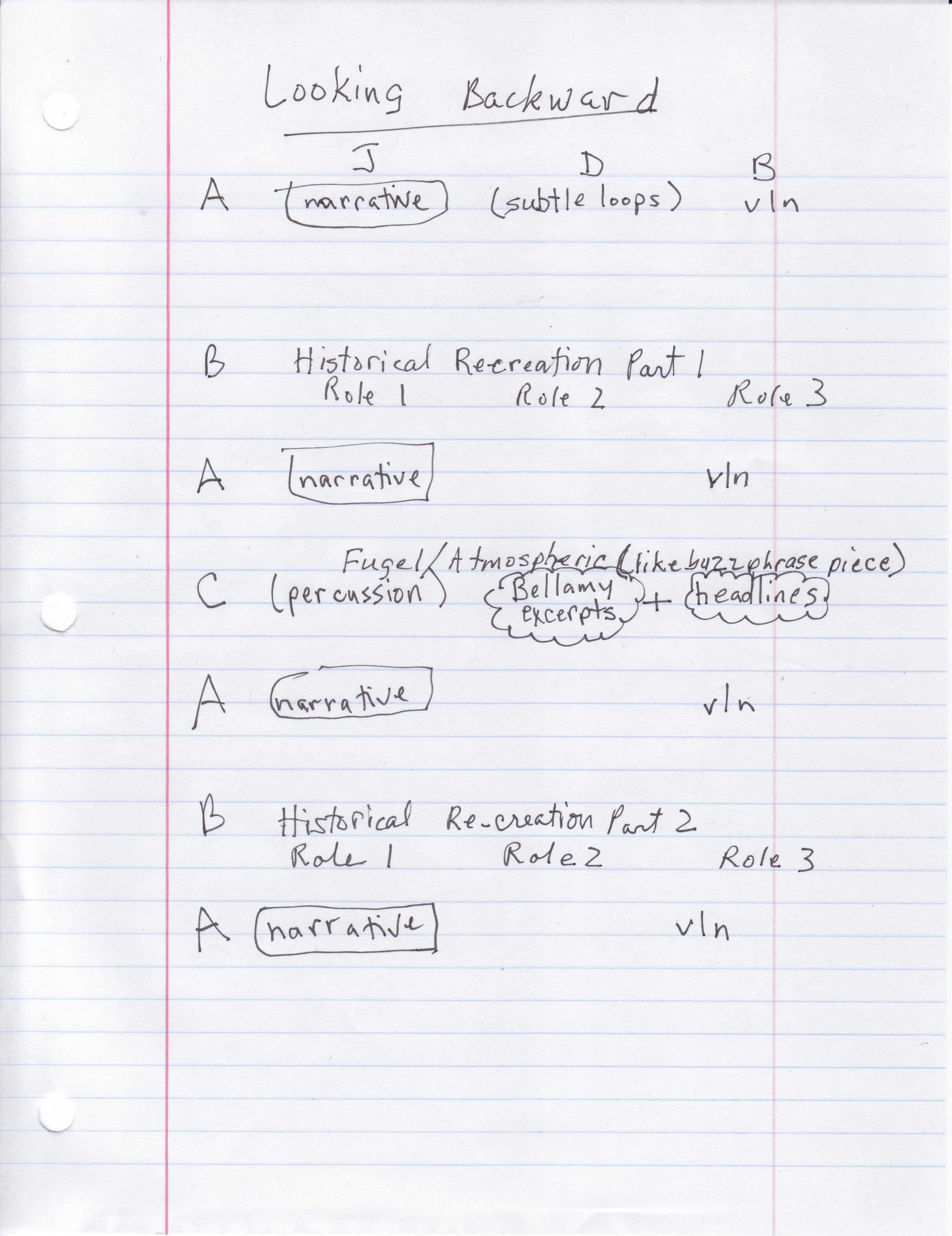
Rebecca’s diagram for Looking Backward
Meanwhile, Rebecca continued the process and devised this impromptu score.
Back to Contents
Useful Links
- Sumner Hunt: https://en.wikipedia.org/wiki/Sumner_Hunt
- George Wyman: https://en.wikipedia.org/wiki/George_Wyman
- The Bradbury Building
- Wikipedia: https//:en.wikipedia.org/wiki/bradbury_building/
- LA Conservancy:
- https://www.laconservancy.org/locations/bradbury-building
- Handout for visitors:
http://www.publicartinla.com/Downtown/Broadway/Bradbury/brad_hist.html [dead link as of 2023-03-09]
- UC Davis University Library’s “Bradbury Family Papers” web exhibit:
https://www.library.ucdavis.edu/exhibit/bradbury-family-papers-mexican-american-familys-story-1876-1965/ - Our version of Edward Bellamy’s Looking Backward: https://www.gutenberg.org/files/624/624-h/624-h.htm
- http://thepoliticalcarnival.net/2011/07/04/benjamin-franklins-views-on-taxation-and-private-property-would-sound-downright-marxist/[old link]
- Ben Franklin. Pretty Hobbesian, IMhO
- [Ed note 2020/12/18: The site is gone…
Meta: Migrate Scaffolding to This Page
I’m kinda happy with the prose notes for whatever we eventually speak. Suggest that the prose is scaffolding for emergent “poetry”, and that we preserve some of it by transplanting it to this page.
Mr_Yesterday responds….
Hm. To me the scaffolding is very interesting and some suitable for framing, as it were. Both images we had up were part of the project. (“Preserve some of it?” WTF, someday it may be all there’ll be. YouTube won’t stay free forever….) Definitely not “Talk” in the usual wiki usage (more below). I would much prefer a “Scaffolding” or other introductory page to this relegation to obscurity and, ultimately, death by disinterest.
Unless, of course, you believe books for adults are prohibited from having illustrations. Or wished to preserve the sanctity of only the text itself. I wasn’t thinking the finished product would everactually live on the wiki—where it can be edited “mercilessly” by anybody—once the work had been performed; we’ll enshrine it on the blog pages or elsewhere, after agreeing whether it will be ©, (cc)BY-SA, or restricted from commercial use by the legal entities constituting wikiGong.com, cast in bronze, or what have you.
I could see breaking the whole business up into sub-pages—Score, Stage Directions, References, etc.—which could then be included in some humongous super-page by transclusion. Maybe. But that’s a lot of effort for a fleeting work in progress.
In brief: I was more than a little POed to see some of my best work of the day (IMH-effin’ artist’s opinion) vanish, and only mildly mollified to find it had merely been banished unceremoniously and sans discussion to a Talk page. Talk is for discussing that first.
—Mr Yesterday 20:48, 26 August 2012 (MST)
Meta: Talk page etiquette
“Talk” on a wiki is about the page (or project) you’re crafting. Generally it’s where we’d discuss things like moving whole mounds of content to the Talk page before actually doing it. Good guidelines here, I thought. Also key element is signing comments so we don’t get lost, which MW helps with by using three (handle only) or four (handle plus timestamp) tildes.
—Mr Yesterday 20:48, 26 August 2012 (MST)
Also, if we go around moving stuff like this—it did, after all, simply disappear to nowhere evident, unless you have established use of Talk pages as part of your editorial M.O.—it might be good to add the appropriate Category links to the Talk pages as well. It can be done at the end of the page (traditional and best practice) but also inserted mid-stream if convenient.
—Mr Yesterday 20:58, 26 August 2012 (MST)
Oh, yeah. Don’t put anything back on my behalf. It’s out of my system now. We still should discuss working assumptions some time to mitigate the risk of future misunderstandings…
—Mr Yesterday 21:04, 26 August 2012 (MST)
Layers vs. Sections
“Layers, not sections”: What do you mean, Dave?
—Jjldickinson 17:57, 25 August 2012 (MST)
The three original aspects of the piece, in my (very) rough notes were:
- Bellamy
- Bradbury
- Belle Epoque
Because they appeared this way, in a linear outline, this might be construed as the work having three “movements,” like Oracle_du_Jour But in my mind’s eye—and as we’d discussed that evening, if I remember aright—this piece has three confluent streams instead.
Bek captured the whole business in her 3×7 matrix, which also mapped the streams to people. So my loopy lines may be evocative, but her directions are precise.
—Mr Yesterday 21:16, 26 August 2012 (MST)
Mark Hammons re: Loss Evinced by Bradbury Building
From 8/25/2012 email:
I will touch more on this when I can spend more time, but what you are getting at is the loss of an entire national moment when there was a hopeful outlook–the trusts were being busted, the Progressives were on a roll, there was a rising tide of social welfare causes, all of the many diverse elements that treated democracy as an active, living spirit manifested in America for the first time in the history of man. There was a genuine faith in both the capacity of the goodness of human beings, coupled with the incredible inventiveness of technology, and these things would coincide together as Utopia for real. It wasn’t just the socialist agenda, it was the broader sweep of American exceptionalism. And all it took was a secret agreement between Old World powers that brought about WWI, and that was the end of that. Wilson was a rube Yankee and never saw it coming.
—Jjldickinson 00:12, 26 August 2012 (MST)
LA Conservancy vs. Actual Architect’s Identity
From https://www.laconservancy.org/locations/bradbury-building:
The identity of the building’s final architect is a subject of debate. Lewis Bradbury, a mining and real estate millionaire, commissioned Sumner Hunt to create a spectacular office building. Hunt turned in completed designs, but was replaced soon after by George H. Wyman, who supervised construction.
According to Wyman’s daughters, he was asked to take over because Bradbury felt that Wyman could understand his own vision for the building better than Hunt, although there is no evidence that Wyman changed the design. Wyman later designed other buildings in the Los Angeles area, but the Bradbury Building (if indeed it was designed by Wyman) was to be his only work of lasting significance, whereas Sumner Hunt went on to design many other notable buildings, including the Southwest Museum.
—Jjldickinson 14:07, 26 August 2012 (MST)
One Man’s Discovery
A writer found work in downtown Los Angeles, a few blocks away from what he knew, where many buildings were a few decades older. He felt the river of time sweep him through the world, and sought to make this time and place his, like others. What was this place? Food. People. Sounds. Buildings.
Waiting for a meeting, 20 floors up, he studied the rough texture of old buildings.
A hypertrophied, glazed canopy almost covered one block of brick and stone. Seemed familiar. Could it be?
Echoes
Being a variety of excerpts from email, giving some chronology to my personal discovery of the Bradbury Building.
- From 5/10/2010 email:
It might be fun to walk through the downtown library, but I’m not sure when it opens. The Museum of Contemporary Art probably doesn’t open until the afternoon–or would they be closed Tuesday? And they’ll want money. (Free Thursdays, starting 5 PM, I think.) In any case, there’s plenty of street life and interesting buildings. (I know the Bradbury building is nearby, and I still haven’t seen it.) - 5/17/2010:
I ate in the Gas Company cafeteria today, in a weekly lunch at which many members of the IS department gather. Apparently members of Frank’s group find it useful to mix with this group now and then. However, there’s something wrong with not leaving the building all day, so I went out for a walk afterward. Continuing the weekend’s retro science fiction theme, I found the Bradbury Building and walked through its lobby. I had forgotten that the building’s designer actually got his inspiration from a science fiction novel (besides the fact that a number of Blade Runner scenes were filmed there). Cool place. I got a number of cell phone photos.
Also this:
One nice add-on to the Bradbury Building trip was that the nearest cheap, funky breakfast place I saw (e.g. pancakes, eggs, sausage) was called something like “Cafe de China.” Maybe that wasn’t the exact name, but the point is: Spanish name, promising Chinese food, offering traditional American breakfasts. Yup. [I don’t think it’s there anymore.] - 5/25/2010:
Two recent co-workers joined me for lunch, and I retraced my previous steps with the Nikon F, instead of just my cell phone. I got some more photos of Grand Central Market (love all those neon signs, among other things) and the lobby of the Bradbury building. (Damn! I forgot to take any exterior shots! What was I thinking?!) (Well, I was talking to friends….) Pretty soon I will have some photos from 35mm which overlap or duplicate previous cell phone photo subjects. It will be a good, direct comparison. - 5/29/2010
Remember I mentioned I had some 35mm Bradbury Building photos, which might offer a good comparison with what I captured with my cell phone? They’re uploading right now. The uploads are actually 50% reductions of what I got from X, to comply with Flickr file size limits. X gives me 7056 x 4680 pixel scans. Not bad! - 6/25/2010
L, the photographer and gallery volunteer, took the Blue Line up this morning–which he enjoyed, as it happens. He called and met me and J, one of Frank’s project managers, on the sidewalk. J led us down an alley a few blocks northeast of here, to the Lost Souls Cafe. I wanted to go there for the name alone, and I knew L would feel the same. In fact, it was a decent and inexpensive place, besides being hipper than most places that would have allowed us in.
On the way back, we detoured a block to walk through the Bradbury Building. We’d all seen it, but L hadn’t seen it for a very long time; probably since before it was restored in the 90s, to hear his description. It was a very enjoyable lunch and walk. - 8/7/2010
We went to downtown LA for dinner. It was pretty nice. Drove up the 110, and then the GPS directed me off the freeway to surface streets for the last 5-6 miles (e.g. up Figueroa past USC). I’m really not clear on all the GPS logic, or even whether I have a subscription to real time traffic data for awhile as part of the purchase. Tonight made me think it might, since the 110 was jammed, and I’m pretty sure the instructions had me going straight up the 110 to a downtown exit when I set up the restaurant’s address in the GPS at home. After dinner, I zig-zagged through downtown, past the Bradbury building and on to Little Tokyo, where I’m familiar with how to get back on the freeway and continue a few miles southeast, to the 710. After that, it’s easy–except that Alex’s random whistling was like an ice pick in my brain. And I had dessert and coffee at the restaurant, so there was no point in following the tug on my heart from the Tierra Mia coffeehouse in South Gate, as I zoomed past the Firestone exit from the 710… - 9/15/2010
High points of the day:- Discovering that the Mexican seafood place has re-opened.
- Trying their fried oysters. Muy bueno! Good idea.
- Helping French tourists find the Bradbury Building.
- Good session with Leslie.
- 10/10/2010
Anyway, it was fun. I didn’t think it was likely that Todd would go for it, since the distance was trivial and we had to drive to get there. But hey, it was my car, not his, and he rode about 35 miles yesterday, so he figured he’d paid his dues. Although he complained a lot about the clownish riders, he also expressed real pleasure about having gone.
I carried the Nikon on a chest harness I bought when I was in college and which I’ve finally found value in, during the last few years. The UW bookstore carried it. It was marketed as a great thing for e.g. hikers, cyclists, and skiers. (I can just imagine a skier punching a hole in his sternum, skiing into a tree with a bulletproof Nikon F strapped to his chest.) Of course the company that made it went out of business long ago…
After turning around in Boyle Heights, we detoured one block so I could show Todd the Bradbury building. He was intrigued, but wouldn’t take me up on my offer to hold his bike while he took a look inside, because he didn’t want to go in wearing bike shoes. “I’ll come back later.” Sigh…right. Dude…carpe diem! He was more impressed by decoration on the building across the street; but you can’t really see what makes the Bradbury building so distinctive from the outside. - 11/12/2010
This might be an interesting place to visit:
https: //www.lamountains.com/parks.asp?parkid=’32′[old link]. It might be a fairly convenient combination with the Bradbury building and seafood tacos. - 7/9/2011
I drove Dave past the Bradbury Building before getting back on the freeway and coming home to freeze homemade cherry ice cream, for which I’d prepared the ingredients earlier. (Sorry you missed it!) I wanted to pounce on those farmers’ market cherries while they’re in season. When I don’t, I regret it the rest of the year. Next seasonal target: peaches. We talked and I watched Dave’s video from Zenshuji and later. Now that I’ve showered and shaved, I feel like a new person, so I’ll go watch his video from this morning.
Journal
What’s…special…about it.
Dave (relayed by Becky): My dad was an architect. Well…yeah…. So that’s by way of explaining an interest in architecture? [This is actually key. I happen to think architecture impacts quality of life. I want to believe that better architecture helps make better people. This is fantasy to most people. The gray flannel view is that architecture has no practical value. The hippie view is that it’s crass, material world stuff (apart from feng shui nut cases). In fact, architecture /does/ occupy a peculiar and demanding space between ethereal art (it should be beautiful) and practical engineering (it should keep people dry). Why do I believe that architecture is important?]
Oh, wait. I get it. So there’s an extra nostalgic, elegiac, emotional quality to my relationship with architecture. [Wouldn’t you know it? This parallels the theme of loss which runs through much of our stuff: that “elegiac” thing. Loss in what sense? Not of anything that physically existed. What we’re talking about is the difference between what is and what people hoped might be: “The future ain’t what it used to be,” as brought to a head in Dave’s “Where’s My Future?” rant at the 2011 Long Beach SoundWalk. If “loss” is the right word, it’s the loss of a hope, a dream, or potential.]
OK. Maybe.
But about that architecture: What is it, really? Not Beaux Arts, really, is it? Maybe it is, in its ornamentation. Not Prairie School. What? Some imitative genre? [Mark Hammons says “Romanesque.” Duh! However, he qualifies this with some more specific considerations.]
What distinguishes the building, of course, is sui generis: the hypertrophied skylight and illuminated atrium. (“Into every atrium some rain must fall,” quipped Bob Kutak. Maybe, but less in LA than in many other places.)
So one cool thing about the atrium is how it prefigures airy, luminous structures much more easily achieved with more modern materials and engineering. [Mark Hammons suggests that at its debut, the Bradbury Building was probably in the vanguard of quick evolution in fireproof construction, compromised to some extent by the amount of oak trim.] And there is something elegiac: the yearning of something barely in reach, but not graspable. The yearning that motivates heroic effort.
Even if one knew nothing about the Bradbury Building’s back story, the relationship of the skylight and pellucid atrium to the massive brick and stone exterior, which appears to support the skylight, suggests this yearning, this struggle, to capture light with hands of clay, to catch butterflies with feet of clay. Golem running through the meadow. Little red ochre boy with Olmec head running through flowers [and that’s where something cut me off].
The Reality
What belongs here?
One thing that comes to mind: The lobby usually reeks of Subway sandwiches. Sigh….
But wait! There’s the whole noisy bustle of discount shopping (mostly conducted in Spanish) as one approaches from the south. Many of my photos were deliberately intended to document this transit.
Now we’re talking.
This page was last modified on 27 April 2020, at 18:08.
Page created 17:55, 25 August 2012 by Jjldickinson.
